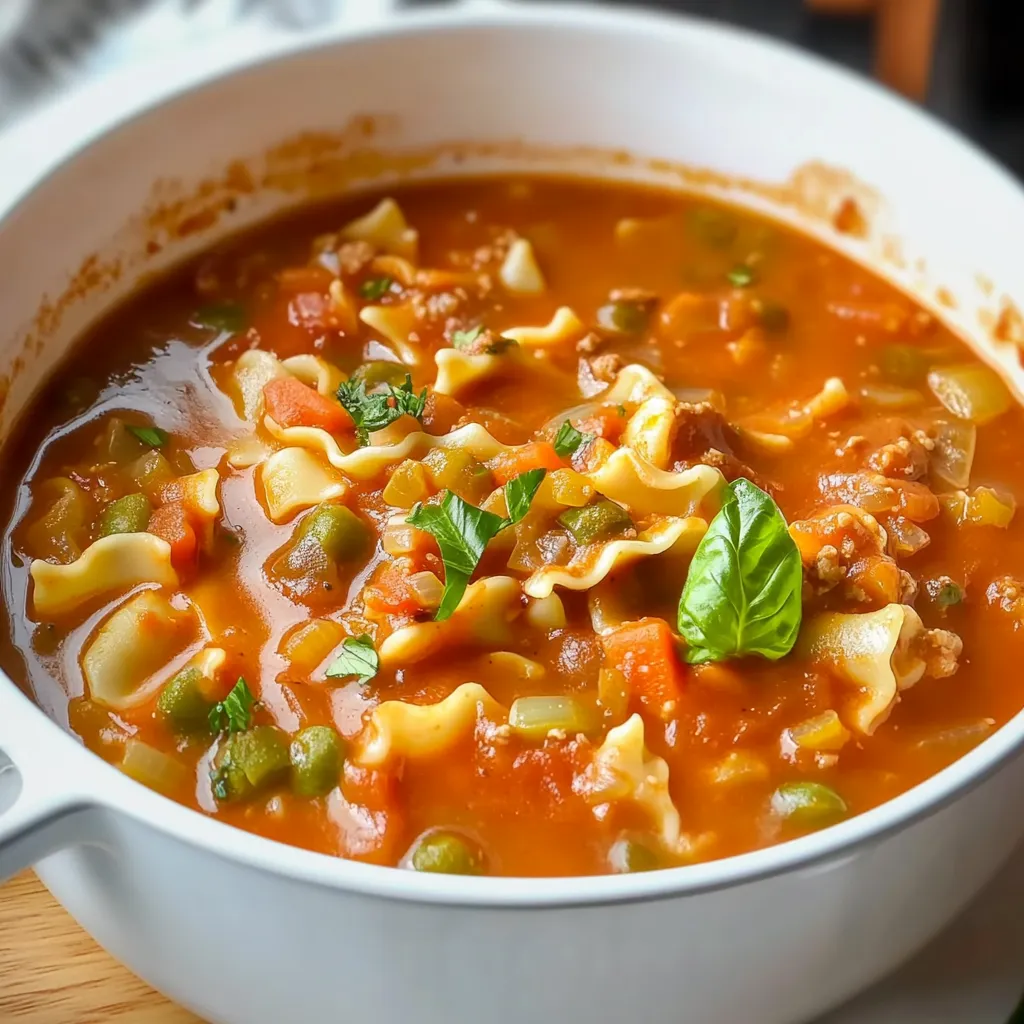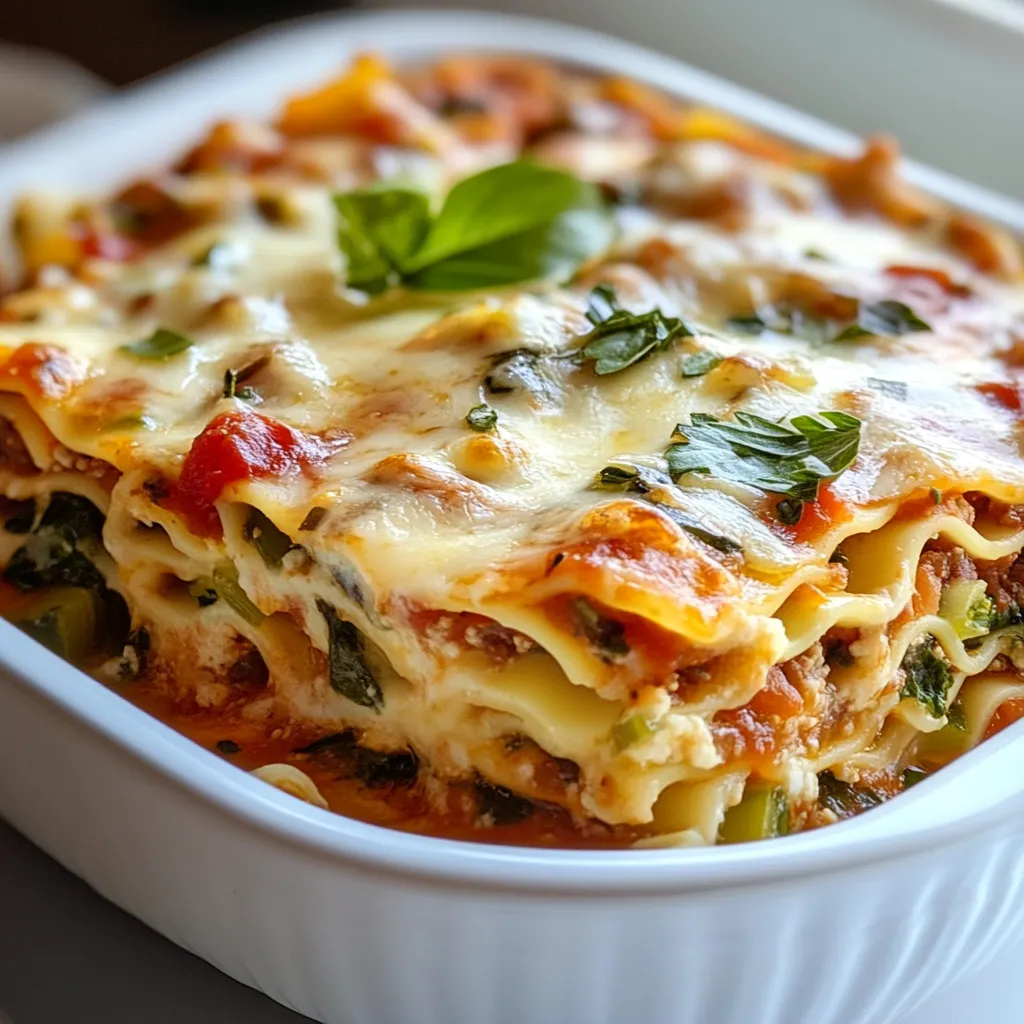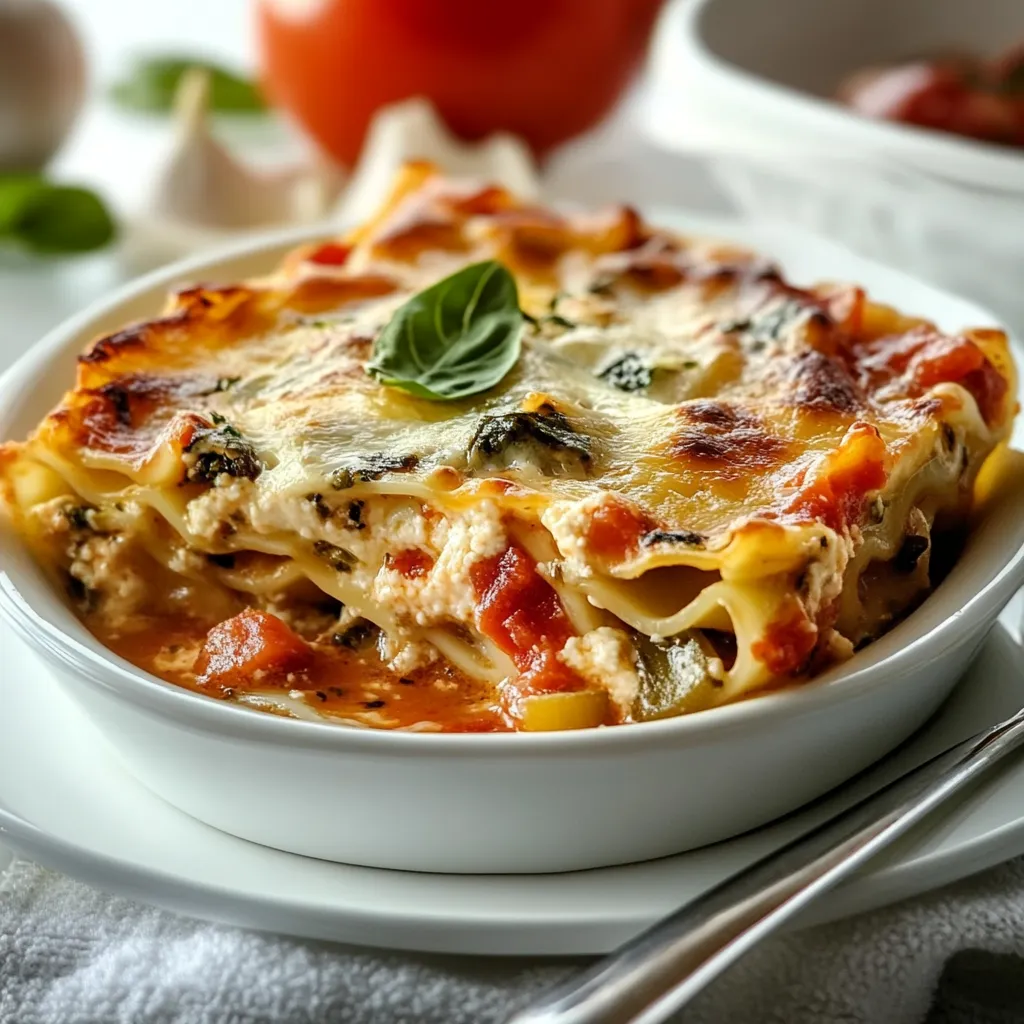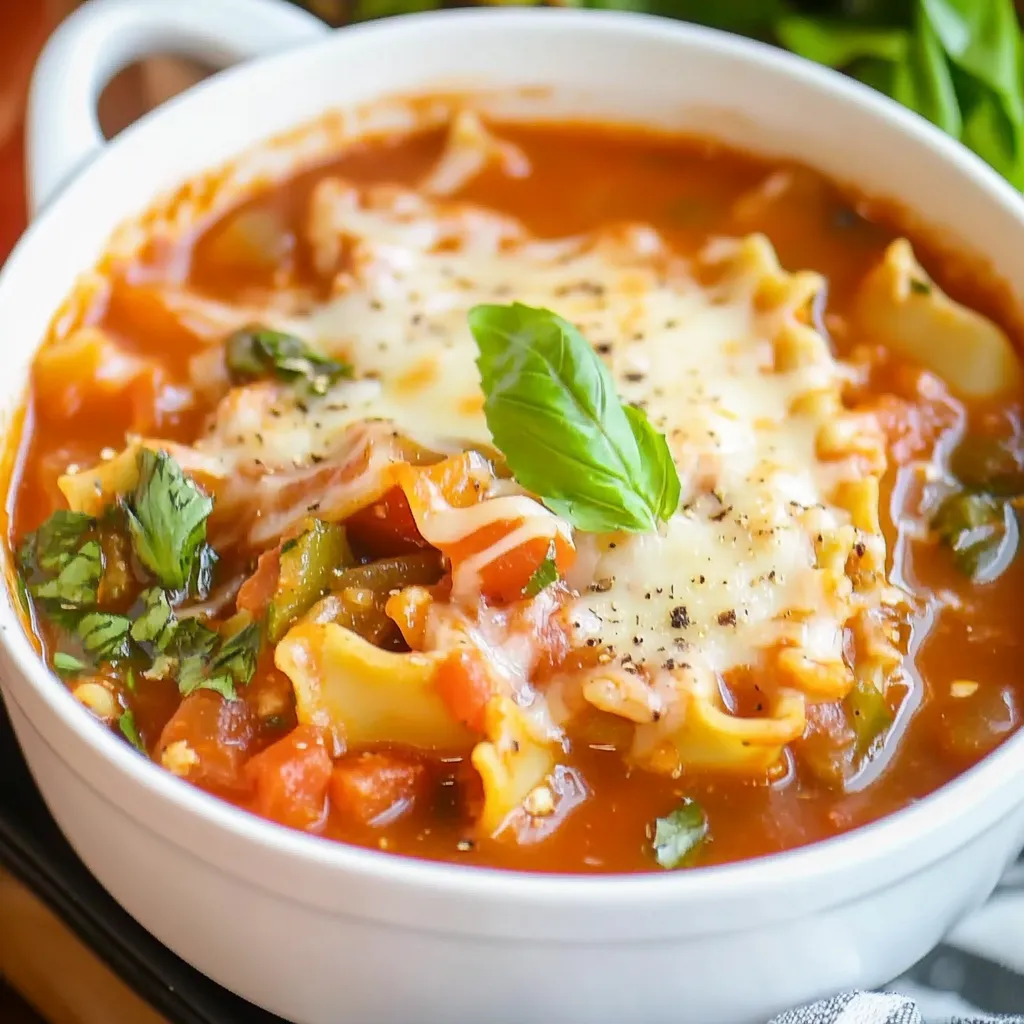If you love lasagna but find the preparation a bit too fussy for busy evenings, then this veggie-loaded lasagna soup might be the perfect solution for you. Combining all the comforting flavors of traditional lasagna with the convenience of a soup, this recipe is easy to make, healthy, and satisfying. Packed with vegetables like carrots, zucchini, and spinach, it’s a dish that combines the richness of lasagna without the hassle of assembling layers.
This recipe isn’t just for vegetarians—it’s a great option for anyone looking to incorporate more vegetables into their diet while still enjoying the comforting flavors of a classic Italian meal. The best part? It’s easily customizable to fit dietary preferences like vegan, dairy-free, or gluten-free. Whether you want to enjoy it on a cold evening or prepare it ahead of time for meal prep, veggie-loaded lasagna soup offers the perfect balance of comfort and nutrition.
In this article, I’ll walk you through the recipe, share some tips on making it your own, and explore the nutritional benefits of this hearty and wholesome soup.

Why You’ll Love Veggie-Loaded Lasagna Soup
This veggie-loaded lasagna soup is packed with flavor, nutrition, and versatility. Here’s why it should be your go-to recipe:
-
Healthy and Nutritious: Loaded with vegetables, this soup is high in fiber, vitamins, and minerals. It’s a great way to get your daily dose of veggies while enjoying a comforting dish.
-
Easy to Make: Unlike traditional lasagna that requires multiple layers and baking, this soup comes together in one pot. It’s perfect for busy nights or anyone looking for a simple meal that doesn’t skimp on flavor.
-
Customizable: Whether you’re vegan, gluten-free, or prefer to add some protein, this recipe can be adjusted to meet your dietary needs. You can use vegan cheese or meat alternatives to suit your preferences.
-
Meal Prep Friendly: This soup is great for making ahead of time. You can easily store leftovers for lunch or dinner the next day, and it reheats beautifully.
-
Comforting and Hearty: With its rich, tomato-based broth and tender vegetables, this soup is the ultimate comfort food. It’s a warm, hearty dish that feels like a hug in a bowl.
Ingredients for Veggie-Loaded Lasagna Soup
Before diving into the recipe, let’s look at the ingredients that make this veggie-loaded lasagna soup so special. The beauty of this dish lies in its simplicity, with fresh, wholesome ingredients coming together to create a flavorful soup.
Main Vegetables:
-
Carrots: Provide a natural sweetness and are a great source of beta-carotene.
-
Zucchini: Adds a mild flavor and light texture while contributing vitamins A and C.
-
Spinach: Fresh spinach brings in iron, folate, and a leafy green texture that blends well into the soup.
-
Onions: A savory base flavor for the soup.
Broth and Sauces:
-
Vegetable Broth: The base of the soup, bringing depth and flavor.
-
Marinara Sauce: Adds richness and that signature Italian tomato flavor. It’s a shortcut to adding flavor without having to make your own sauce.
-
Balsamic Vinegar: A touch of balsamic vinegar adds a slight tanginess that balances out the sweetness of the carrots.
Noodles:
-
Lasagna Noodles: Broken into small pieces, these noodles give the soup the hearty, comforting texture of lasagna without the need for layering.
Seasonings and Toppings:
-
Salt and Pepper: Essential for seasoning the soup.
-
Parmesan and Mozzarella: These cheeses are optional but add richness and melt beautifully on top of the soup. You can use dairy-free alternatives to keep the soup vegan.
-
Fresh Basil: For garnish and a burst of fresh flavor to finish off the soup.

Variations and Customization Tips
This veggie-loaded lasagna soup is incredibly adaptable. Here are some easy variations and substitutions to make the soup your own:
-
Use Different Vegetables: Feel free to add more vegetables such as mushrooms, bell peppers, or kale. The recipe is great for using up what you have in your fridge.
-
Make It Vegan: To keep the soup vegan, simply omit the cheese or use a dairy-free cheese alternative like cashew-based ricotta or almond mozzarella.
-
Add Protein: If you’re looking to add more protein, try adding white beans, chickpeas, or even some cooked lentils. Ground meat like turkey or beef can also be added if you’re not following a vegetarian or vegan diet.
-
Use Gluten-Free Noodles: For a gluten-free version, simply swap the lasagna noodles for gluten-free pasta or zucchini noodles.
Health Benefits of Veggie-Loaded Lasagna Soup
Not only is this soup delicious, but it’s also packed with health benefits. Here’s a breakdown of the nutritional advantages of this veggie-loaded soup:
-
High in Fiber: With ingredients like carrots, zucchini, and spinach, this soup is a great source of fiber, which helps support digestive health and keeps you full longer.
-
Rich in Vitamins: The carrots and spinach provide an excellent source of vitamins A and C, which are essential for eye health and boosting the immune system.
-
Anti-inflammatory: Ingredients like balsamic vinegar and vegetables like zucchini and spinach have anti-inflammatory properties, which can help reduce the risk of chronic diseases.
-
Low in Calories: With the use of fresh vegetables and vegetable broth, this soup is naturally low in calories, making it a great option for those looking to maintain a healthy weight.

Storing and Reheating Veggie-Loaded Lasagna Soup
This veggie-loaded lasagna soup makes for fantastic leftovers, perfect for meal prep or a quick dinner on busy days. Here’s how to store and reheat it:
Storing Leftovers
-
In the Refrigerator: Allow the soup to cool completely before transferring it to an airtight container. Store it in the fridge for up to 4-5 days. When you’re ready to eat, just reheat it on the stove or in the microwave.
-
In the Freezer: This soup freezes well, so if you want to save it for later, allow it to cool and store it in freezer-safe containers. It can last for up to 3 months in the freezer. To reheat from frozen, allow the soup to thaw in the fridge overnight, then warm it on the stove. You can also reheat it directly from frozen on low heat, though this will take a bit longer.
Reheating the Soup
-
Stovetop: Reheat the soup on medium heat in a pot, stirring occasionally until it’s heated through. If the soup has thickened too much, you can add a splash of vegetable broth or water to thin it out.
-
Microwave: For a quicker option, transfer the soup to a microwave-safe bowl and cover it with a microwave-safe lid or paper towel. Heat for 2-3 minutes, stirring halfway through, until warmed through.
Can I Make Veggie-Loaded Lasagna Soup Ahead of Time?
Yes, you can absolutely make this soup ahead of time. In fact, the flavors develop even more as the soup sits, making it even better the next day! Here’s how to make it in advance:
-
Prepare the Soup: Follow the recipe as directed but stop right before adding the spinach and cheese.
-
Cool and Store: Allow the soup to cool completely, then store it in an airtight container in the fridge for up to 4-5 days or freeze it for up to 3 months.
-
Finish Later: When you’re ready to serve the soup, simply heat it up, then stir in the spinach and cheese until the spinach is wilted and the cheese is melted.
This make-ahead option is perfect for busy weeknights or meal prepping for the week ahead.
FAQs On Veggie-Loaded Lasagna Soup
What veggies to put in lasagna soup?
For a veggie-loaded lasagna soup, you can use a variety of vegetables that will add flavor, texture, and nutrients to the dish. Some great options include:
-
Carrots: Adds natural sweetness and a nice crunch.
-
Zucchini: Light and softens well, blending nicely with the other flavors.
-
Spinach: A great leafy green that wilts down into the soup, adding nutrition without overpowering the flavor.
-
Mushrooms: Offer a savory umami flavor that complements the tomato base.
-
Bell Peppers: Sweet and slightly crunchy, they add color and depth.
-
Onions: Essential for a savory base, they provide a rich, aromatic flavor.
Feel free to experiment with other vegetables such as kale, peas, or leeks, depending on your taste!
What vegetables go with lasagna?
Lasagna is a versatile dish, and a variety of vegetables can complement the layers of pasta and cheese. Here are some vegetables commonly found in lasagna:
-
Spinach: A classic choice, it pairs beautifully with ricotta or mozzarella cheese.
-
Zucchini: Often used in place of noodles in some vegetable lasagna recipes, it adds texture and moisture.
-
Mushrooms: Add an earthy flavor that blends well with tomato sauce and cheese.
-
Bell Peppers: Provide a sweet and slightly crunchy texture that adds color to the dish.
-
Onions: Bring out the savory flavors and add richness to the sauce.
-
Carrots: Their natural sweetness balances well with the richness of cheese and tomato.

How do you keep veggie lasagna from getting soggy?
To prevent veggie lasagna from becoming soggy, try these tips:
-
Cook the Vegetables First: Sauté or roast your vegetables before layering them in the lasagna. This helps remove excess moisture, especially with watery vegetables like zucchini and mushrooms.
-
Use Less Sauce: While lasagna needs a good amount of sauce, using too much can lead to a soggy dish. Make sure the sauce is spread evenly, and don’t over-saturate the layers.
-
Pre-cook the Noodles: If using regular lasagna noodles, cook them al dente. This ensures they don’t absorb too much moisture during baking.
-
Drain Excess Water: If you’re using frozen vegetables, ensure you drain out any excess water before adding them to the lasagna.
How to thicken up lasagna soup?
If your lasagna soup is too thin, here are a few ways to thicken it:
-
Add More Noodles: As the noodles cook, they will absorb some of the liquid, thickening the soup naturally.
-
Puree Some of the Soup: Use an immersion blender or regular blender to puree a portion of the soup, which will create a creamier texture without changing the flavor.
-
Use Cornstarch or Flour: Mix a small amount of cornstarch or flour with cold water to form a slurry, then add it to the soup and cook for a few more minutes until it thickens.
-
Add Tomato Paste: Tomato paste is thicker and more concentrated than marinara sauce, so adding a tablespoon or two can help thicken the soup while enhancing the flavor.
Do Italians put vegetables in lasagna?
Yes, Italians do include vegetables in some variations of lasagna. While the classic meat-based lasagna is a staple in Italian cuisine, many Italian lasagna recipes incorporate vegetables, especially in vegetarian or lighter versions. Common vegetables used in Italian lasagna include:
-
Spinach: Often used in combination with ricotta cheese.
-
Zucchini: Popular in vegetable lasagna varieties, offering a light texture.
-
Mushrooms: These earthy vegetables add depth to the lasagna.
-
Eggplant: Used in layered vegetable lasagna, particularly in Southern Italy.
Italian vegetable lasagna recipes can vary by region and personal preferences, but vegetables are an essential part of many lasagna variations.

Veggie-Loaded Lasagna Soup Recipe Card
Ingredients:
-
2 tablespoons olive oil
-
1 cup diced onion (about 1 large onion)
-
1 cup diced carrots (about 2 large carrots)
-
1 cup diced zucchini (about 1 small zucchini)
-
¾ teaspoon salt (divided)
-
2 tablespoons balsamic vinegar
-
2 cups pasta sauce (or marinara sauce)
-
2 cups vegetable broth
-
3-4 cups loosely packed baby spinach, roughly chopped
-
6 ounces lasagna noodles (broken into about 2-inch pieces)
-
⅓ cup grated parmesan cheese (optional, omit for dairy-free/vegan)
-
Shredded mozzarella cheese and/or ricotta cheese for serving (optional)
-
Fresh basil for garnish (optional)
Instructions:
-
Sauté the Vegetables: Heat 2 tablespoons of olive oil in a large pot over medium-high heat. Add the diced onions and carrots, cooking for about 2-3 minutes until the onions start to soften.
-
Add Zucchini: Stir in the diced zucchini and cook until it starts to soften, about 2 more minutes. Season the vegetables with ½ teaspoon of salt.
-
Deglaze the Pot: Add the balsamic vinegar and use a spatula to scrape up any browned bits from the bottom of the pot. This adds flavor to the soup base.
-
Add Sauce and Broth: Stir in the marinara sauce and vegetable broth. Bring the soup to a simmer, and let it cook for about 5 minutes.
-
Cook the Noodles: Add the broken lasagna noodles to the soup and cook for 10-12 minutes, or according to the instructions on the noodle package. Stir occasionally to prevent the noodles from sticking.
-
Add Spinach: Once the noodles are tender, stir in the spinach and the remaining ¼ teaspoon of salt. Allow the spinach to wilt in the hot soup for 1-2 minutes.
-
Taste and Adjust: Taste the soup and adjust the seasoning with salt and pepper if needed. You can also add more broth or water if you prefer a thinner soup.
-
Serve: Ladle the soup into bowls and top with shredded mozzarella, ricotta cheese, and fresh basil if desired.
Notes:
-
Make it Vegan: To keep the soup vegan, simply omit the cheese or use a dairy-free cheese alternative like cashew-based ricotta or almond mozzarella.
-
Use Different Vegetables: Feel free to swap in other vegetables like mushrooms, kale, or bell peppers to suit your taste.
-
Gluten-Free: To make this soup gluten-free, use gluten-free lasagna noodles or zucchini noodles in place of regular pasta.
-
Add Protein: If you want more protein, you can add white beans, chickpeas, or even some cooked lentils.
Nutritional Facts (per serving):
-
Calories: 225 kcal
-
Carbohydrates: 33g
-
Protein: 8g
-
Fat: 7g
-
Saturated Fat: 2g
-
Cholesterol: 5mg
-
Sodium: 1149mg
-
Potassium: 591mg
-
Fiber: 4g
-
Sugar: 8g
-
Vitamin A: 5581 IU
-
Vitamin C: 17mg
-
Calcium: 111mg
-
Iron: 2mg
Prep Time: 10 minutes
Cook Time: 22 minutes
Total Time: 32 minutes
Method: Stovetop
Cuisine: Italian
Servings: 6 servings
Calories per Serving: 225 kcal
Yield: 6 bowls of soup







